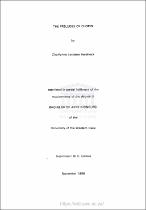| dc.contributor.advisor | Correia, E. | |
| dc.contributor.author | Hardneck, Charllynne Lyndene | |
| dc.date.accessioned | 2023-03-06T09:55:03Z | |
| dc.date.available | 2023-03-06T09:55:03Z | |
| dc.date.issued | 1996 | |
| dc.identifier.uri | http://hdl.handle.net/11394/9688 | |
| dc.description | Magister Curationis - MCur | en_US |
| dc.description.abstract | The essential feature of the prelude is to attract the listener's attention and define the pitch, mode or tonality. This can be the reason why preludes are often written in a selection of 24 maior tonalities. As one of the central features of a prelude is to define the pitch or key of a piece, Chopin's preludes Opus 28 move through a logical tonal sequence of major and minor keys. Chopin did not invent this principle. J.N. Hummel had published a set of 24 preludes in major and minor keys in Opus 67,in the year 1814. It is believed that these works of Hummel influenced Chopin when he later wrote his set of 24 preludes, Opus 28 fi 836-1839). ln his music, Hummel was fond of homophonic
textures with Italian melodies. He also used virtuoso passages in his right handparts, while the left hand would play Alberti accompaniments. Hummel also made frequent use of third-relationships, secondary and tertiary dominants and chromatic passing notes. These traits can also be seen in Chopin's Opus 28. | en_US |
| dc.language.iso | en | en_US |
| dc.publisher | University of the Western Cape | en_US |
| dc.subject | Homophonic | en_US |
| dc.subject | Composer | en_US |
| dc.subject | Soprano | en_US |
| dc.subject | Chromatic | en_US |
| dc.title | The preludes of Chopin | en_US |
| dc.rights.holder | University of the Western Cape | en_US |

